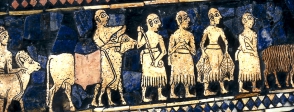
The Standard of Ur is a box, the two large sides of which show aspects of life in early Mesopotamia. The purpose of the object remains unknown. Woolley though it might have been mounted on a pole and carried – hence its name. Others think it may be the sounding box of a lyre. The decoration on each side is divided into three levels (registers) which can be read from bottom to top. One side shows scenes of peace and the other scenes of war.
War and peace
The war side shows a Sumerian army and scenes of warfare. On the bottom level are chariots pulled by donkeys which are trampling enemies. The chariots move faster as they move from left to right. Further up the levels there are infantry soldiers with cloaks carrying spears, enemy soldiers being killed with axes, prisoners being paraded naked and presented to ruler who appears at the top carrying a spear and larger than all the other figures.
On the other side of the Standard, the bottom two levels show workers of all sorts carrying bags on their shoulders, probably containing fresh produce, and backpacks supported by headbands. There are men leading donkeys as well as bulls, sheep and goats; others are carrying fish. At the top there is a royal banquet. The ruler, wearing a woollen fleece skirt, is seated before his guests who are also dressed similarly, though less extravagantly. The banqueters are served by attendants and entertained by a singer and musician playing a lyre.
What the Standard tells us about life in an ancient Mesopotamian city
Ur was one of the first village settlements founded around 4000 BC in an area of Mesopotamia known as Sumer, and by 2800 BC it had become one of the most prosperous city-states in the region. As the first cities developed, increased population led to the establishment of complex systems of administration and record-keeping and increased wealth gave rise to social hierarchies, specialist roles within society and the need for more organised forms of protection.
The peace side of the Standard shows how the city, and in particular the ruler, draws upon the agricultural and natural resources of its territory. Agricultural success was necessary to the growth of a city-state and to the benefits it brought to the people. It was also on this success that the ruling group could build a courtly lifestyle involving feasting and entertainment. Agricultural surplus could be used to trade exotic foreign goods, such as the materials used to decorate the Standard, which came hundreds or thousands of miles from the Persian Gulf (the white shells), Afghanistan (the blue lapis lazuli) and India (the red stones).
On the other side, the Standard portrays warfare as a means of protecting the wealth of the city-state from outsiders. The organised nature of the army, their equipment and their conquest of enemies can be seen as symbols of the ruler’s power and status.
One further reason why the Standard is valuable to our understanding of ancient cities is that it shows a range of people – prisoners, warriors, agricultural workers, musicians – overseen by the ruler positioned at the top and shown larger than everyone else. So even though the purpose of the Standard of Ur remains uncertain, the message it conveys is very clear: that a society’s prosperity is generated through social organisation of its people, and the protection and management of its resources.
More information
Introduction to the Standard
Information on the Standard of Ur from the British Museum website.
https://www.britishmuseum.org/explore/highlights/highlight_objects/me/t/the_standard_of_ur.aspx
A History of the World in 100 Objects
A History of the World in 100 Objects on the BBC website.
http://www.bbc.co.uk/ahistoryoftheworld/objects/cVczEWH0RVm_dFZtJBAjRw
BBC History
A useful article from BBC History.
http://www.bbc.co.uk/history/ancient/cultures/mesopotamia_gallery_04.shtml
The Standard of Ur in detail
A very useful and detailed 10-minute video from the Khan Academy website looking at the Standard of Ur in detail.
https://www.khanacademy.org/humanities/history/ancient-medieval/Ancient/v/standard-of-ur--c--2600-2400-b-c-e
Introduction to Mesopotamia
General notes about ancient Mesopotamia from the British Museum website.
https://www.britishmuseum.org/PDF/Visit_Mesopotamia_KS2b.pdf
Mesopotamian objects
Online Mesopotamian collections from the Ashmolean Museum in Oxford.
http://www.ashmolean.org/ash/amps/iraq-navel/index.html
More information
-
Introduction to the Standard
Information on the Standard of Ur from the British Museum website.
Source: britishmuseum.org
-
A History of the World in 100 Objects
A History of the World in 100 Objects on the BBC website.
Source: bbc.co.uk
-
BBC History
A useful article from BBC History.
Source: bbc.co.uk
-
The Standard of Ur in detail
A very useful and detailed 10-minute video from the Khan Academy website looking at the Standard of Ur in detail.
Source: khanacademy.org
-
Introduction to Mesopotamia
General notes about ancient Mesopotamia from the British Museum website.
Source: britishmuseum.org
-
Mesopotamian objects
Online Mesopotamian collections from the Ashmolean Museum in Oxford.
Source: ashmolean.org


